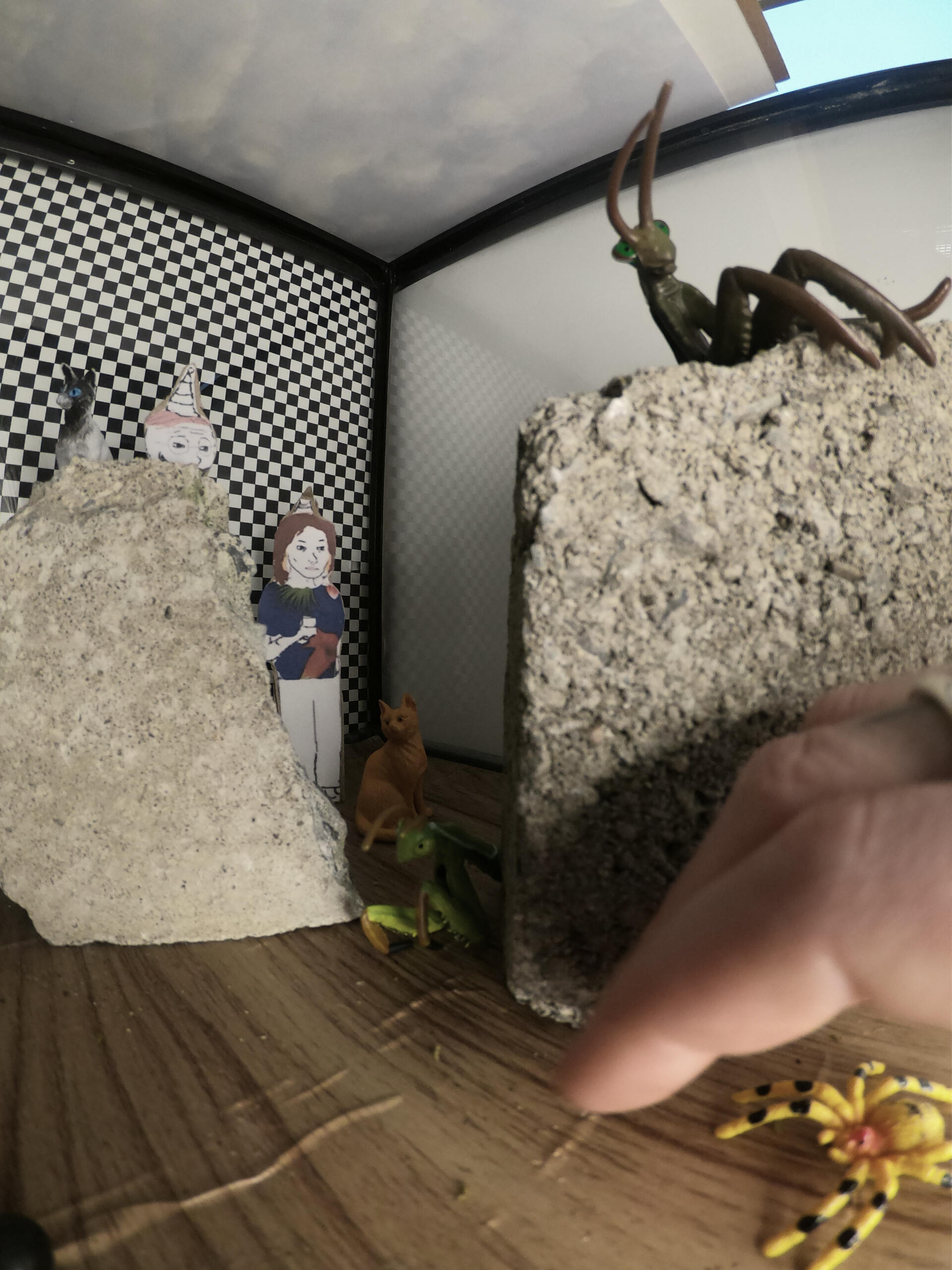Vivarium
mimentomologic
creative research on devouring utopias
The Project

Initiated by a contribution to appear in the academic review musemedusa, Vivarium Mimentomologique is a collaborative research-creation project that focuses on the aesthetics of mimesis and devoration. Traces of these have been retrieved in various entomological archives, that is to say studies concerned by the reproductive gestures of two insects in particular: the praying mantis and the phasm.
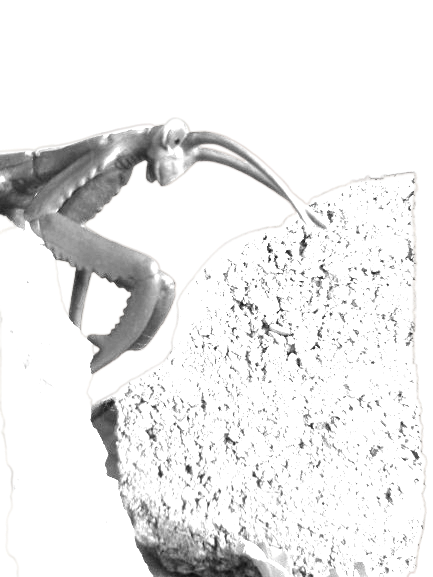
Whereas the phasma reproduces by parthenogenesis, i.e., sexual reproduction without male fertilization, the mantis is renowned for its entomophagous sexuality, i.e., assiduous devouring of the heads of its sexual partners.These two gestures are the main driving forces behind our conceptual and artistic thinking.
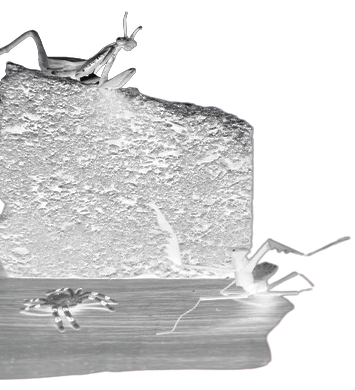
Our approach updates texts and images from entomological archives, staging them in a micro-utopia where embodied simulacra meet.
This approach unfolds in five vignettes photographed from inside a vivarium, simulating the viewpoint of a world of its own (Umwelt) for its inhabitants.
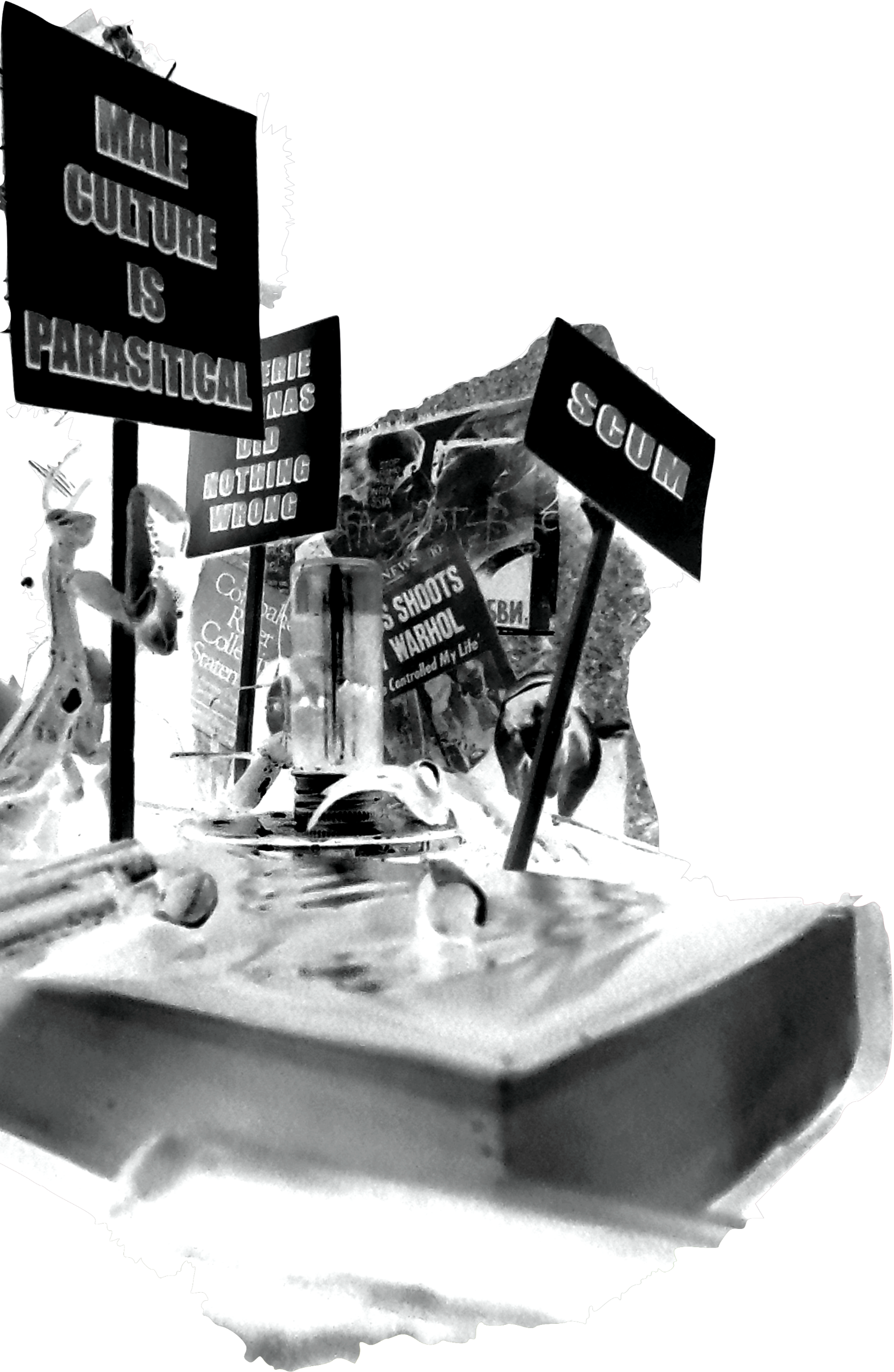
Like the cannibal act, our utopian vivarium intends to restore something that is of the order of the unspeakable, the inhuman, queer and (trans)feminist materialism.
The Vivarium
Our approach seeks to break out of the typographic and literary enclosure to create a visual and symbolic sensuous micro-utopia. Within this tiny world, archival documents, academic texts and pop culture come together in a textured, poetic visual grammar. Reading, once a means of accumulating abstract knowledge individually, is gradually freed up to become a collective, creative and interactive practice.

From scene to scene, we attempt to freeze microscopic fragments of utopian horizons captured in the vivarium. Within the vivarium, we seek to create the simulacrum of a non-heteronormative parthenogenetic society.
To liberate ourselves, we have to sequester ourselves once anew: to create an embodied utopia, we have to contain it within a capsular simulation. A vivarium, gleaned by one of us from his family's storage room of forgotten objects, a mundane material relic of a suburban heteroreprocentric regime, allows us to cobble together various scenes of mimentomological devouring.
Scene 1 | Mimentomological simulacrum: the Vivarium, the Mantis, the Phasm
Unlike utopia, which is traditionally insular and intangible, simulacra are parasitically embedded between real and imaginary realms.
By provoking real effects from false things, it alters the logic of both and generates embodied fictions.

In the vivarium, phasms are mimentomological simulacra that take on plant, human or ornamental forms. In this scene, we can distinguish at least two anthropomorphic phasms and a scholarly mantis.
Scène 2 | Le Festin de l'Arachnophobe, a fabulous opus of heteronormative souvenirs
Our second scene is a fable about heterosexuality, neoliberalism, assimilation by imitation and resistance. It features the Mantis and its vivarium, beset by hetero-homo-normative arachnophobes.
We're reinterpreting Albert Roussel's ballet Le Festin de l'araignée through Le Festin de l'Arachnophobe, an opus featuring the Mantis and her fellow spiders, who are being hassled by a swarm of individuals infatuated with neo-liberal moralism
Determined to take their daily number of steps, a gathering of hetero-homo-normative families and couples crossed the quagmire of the present to the edge of José Esteban Muñoz's utopian horizon.
Exhausted by the journey, they sought refuge in the serenity of the Vivarium mimentomologique to wait for an Uber and feast on keto snacks.

The Mantis, perplexed, observes the strangeness of their heteronormative homogeneity.
- "Did you know that Canada is the fourth country in the world to have authorised same-sex marriage?- Let's get married!-The United States has finally authorised transgender people to serve in the army!
EDI is strength", agreed the others.
The Mantis was appalled and alerted a fellow spider :
-"Dear Spider, can you tell me which of these people is part of the LGBT community?-Well, dear Mantis. Probably that person over there. Doesn't he look like he owns a fracking site to you?
Fortunately, a better-informed spider intervened:
" In 2002, Lisa Duggan coined the term homonormativity to describe the phenomenon of transpédégouine demands being absorbed by neoliberal dogmas such as domesticity and consumerism. By insisting on the private nature of gender identities and non-reproductive sexual practices, neoliberal policies have contributed to the sclerosis and invisibilisation of the queer liberation movements that were consolidated during the HIV/AIDS crisis. Ironically, the term "queer", which was supposed to denote the rejection of institutional identities imposed by the public text and to mark the convergence of sub-political struggles across gender/race/class divides, was quickly co-opted. Having become an electoral and commercial marketing argument, the self-proclamation of belonging to a queer identity is now removed from any reciprocity or community responsibility and is much more a matter of self-promotion than subversion. In fact, queer identity has become an amnesiac marker of resigned deference to dominant economic power, a neo-hegemonic celebration of a supposedly progressive Euro-American exceptionalism. What's more, the rhetorical constitution of homosexuality as a condition that is necessarily either natural or accidental amhhhh... "
BOOM. The erudite spider was fatally interrupted, felled by the panicked palm of a hetero-normative arachnophobe.

Horrified by this demonstration of unabashed speciesism, the Mantis reared back quickly. She had chosen violence.
Defying her predisposition for concealment and cannibalism, she went on the offensive and took revenge. She set about deftly trapping the hetero-homo-norms in the delicate and deadly silk threads woven by her carnivorous comrades. Thanks to this pooling of mimentomological knowledge and community resources, the hetero-homo-normed arachnophobes found themselves, in an instant, as tightly bound as their class consciousness was narrow.All that remained for the Mantis and the spiders was to feast on this homophilic, anthropophagous feast. But after all, wasn't that a neoliberal consecration, to be falsely esteemed only to be swallowed up, dissolved and assimilated?
Scène 3 | Frankie's invasion: from God Trick to Umwelt
In the previous scene, the staging of a fabulous opus pushed this logic to its spectacular extreme, making tangible the artifices of the "God trick", described by Donna Haraway as a gluttonous eye - the cannibaleye - that conquers the world from afar.

As well as maintaining the boundaries between what is inside and what is outside, the vivarium offers itself, in all its transparency, to omniscient observation. Its display case presents without restraint what goes on behind its walls.
Umwelt refers to the functional cycles by which entities and environments are mutually constituted, emphasising that insects' perceptual modes are integrated into the configurations of a given environment. As they distance themselves from anthropocentric approaches to the environment, Uexküll's considerations of insects and their perceptual environments encourage us to pay attention to the nonhuman dynamics of emergence, to their alternative models of perception and to their affective interactions.
The Umwelt : in order to design our vivarium for mantises and cats in a non-intrusive and non-extractive way, we looked at the Umwelt. According to the biologist Jakob von Uexküll, every living species has a universe, the Umwelt, which it understands and interprets from its own point of view. Like Haraway, von Uexküll rejects the scientistic, mechanistic and totalitarian cannibalism that "fucks the world to make techno-monsters". Taking an approach that leaves behind the parameters of human perception, the Umwelt designates the functional cycles by which entities and environments are mutually constituted, emphasising that the perceptual modes of insects are integrated into the configurations of a given environment. As they distance themselves from anthropocentric approaches to the environment, von Uexküll's considerations of insects and their perceptual environments encourage us to pay attention to the non-human dynamics of emergence, to their alternative models of perception and to their affective interactions. Perhaps the vivarium can thus be perceived in an inhuman way, not from an external point of view, but rather from that of an environment made up of affective interactions between diverse entities; from somewhere between Frankie, the cat and the eye that perceives them
This dialectic relationship between the strange and the foreign is highlighted by the closing words of the TikTok user who films the infiltration: "Frankie is not impressed".
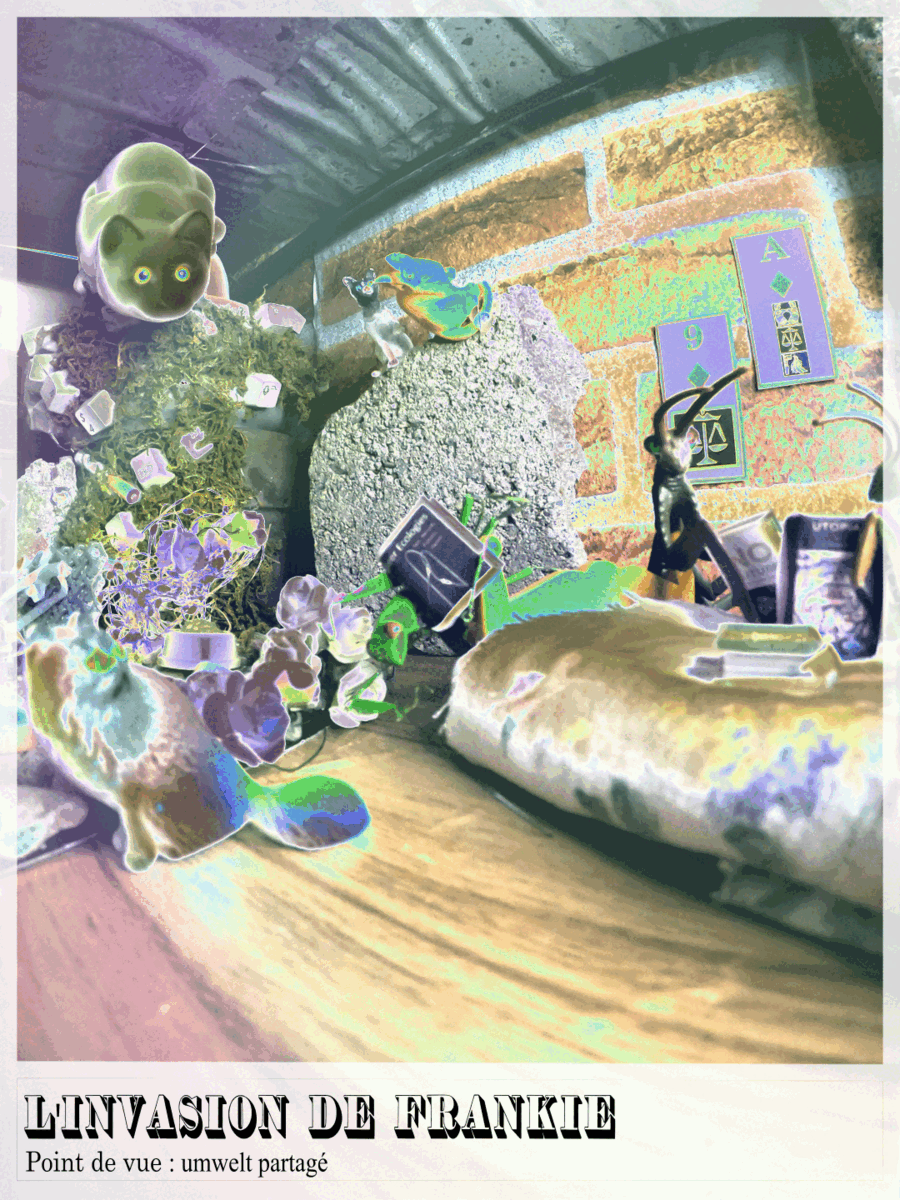
Scène 4 | The Apples of Sodom
These considerations of perceptual reversals take our entomological research to the 17th century, at the very heart of the deployment of transatlantic colonies and complex global circuits of exploitation and extraction, for the purposes of merchandising flowers, spices, labour and fruit.

The vivarium is thus transformed into a yearning ecology of the apple tree of Sodom, both inspired by the critical potential of Merian's illustration and updated by a disarticulation of its colonial iconography.
This is what the association of death with sodomy, depicted in the plate from Merian's herbarium by the elegant encounter of a mantis with the poisonous fruit, underlines: colonialism annihilates, in favour of a hetero-reproductive understanding of living things, ecologies driven by ferocious, disordered and deadly desires.
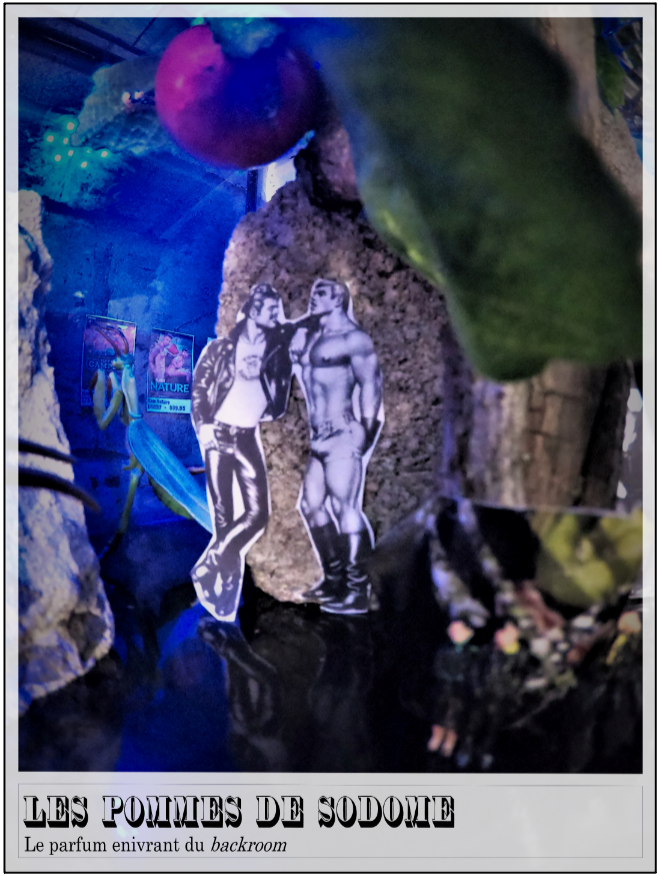
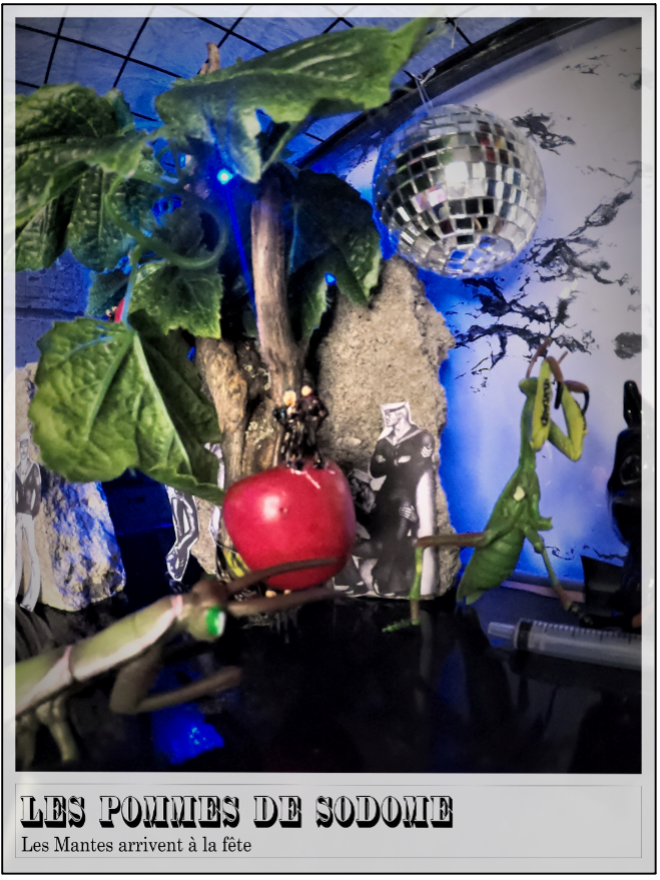
The vivarium is thus transformed into an ecology of desire for the apple tree of Sodom, inspired by the critical potential of Merian's illustration and updated by a disarticulation of its colonial iconography. In this scene, this iconography is hybridised with various iconic figures and artefacts from contemporary queer cultures.Here, the apple tree of Sodom takes root in a club; its leaves unfurl to the rhythm of a photosynthesis nourished by blacklight, neon lights and mirrors; its flowers give off the intoxicating scent of backrooms, showers and toilets; its enticing fruit charms anyone who dares approach it; the digesting bodies, once the fruit has been devoured, metamorphose into a gaping expulsion of latex and amphetamines, pieces of a queer ecology in which the boundaries between human and animal, between the natural and the artificial, and between inside and outside, are continually blurred. While they retain their initial elegance, the mantises join the party with ferocity, relieved that at last devouring is celebrated as a dissident form, even as a transgressive practice. It's because there's devouring that the apple becomes a butt-plug, the soldier becomes an irresistible faggot and nature becomes barebacking.
Scène 5 | The third gender of the Bee Workers

It is astonishing to think that worker bees could, technically, live in complete productive and reproductive autonomy rather than "providing for the needs of the colony".
Perhaps inspired by the communist overtones of certain insect societies, two feminist materialists have put forward utopian ideas for emancipation and the reappropriation of the means of reproduction.
Parasite 1: the producers. Valérie Solanas didn't invent violence, she encountered it. On 3 June 1968, Solanas attempted to assassinate Andy Warhol by shooting him in a New York street. Before that dazzling day, the writer had been in close contact with the artistic milieu that revolved around Warhol and his Factory for about a year. During this period, she lived in extreme economic insecurity. Coming from New Jersey, she hoped to find support and advice to pursue her career as a playwright and novelist. Warhol was neither helpful nor supportive. He lost the manuscript of a play written by Solonas - which he found and produced a year after the author's death - encouraged her to sign abusive contracts, involved her in his films and projects without remuneration, used her ideas without crediting her; in short, he parasitised her36. Gay, white, rich, a self-entrepreneur generating his own personal fortune and extracting resources from the people and things around him, Warhol has all the makings of a liberal utopia.Solanas' violence, like that of the Mantis, is not unjustified. For the Mantis, devouring the male provides the calories it needs to produce eggs, enabling it to reproduce. For Solanas, resorting to violence has ensured her extensive media coverage, which she could not have hoped to achieve by any other means. Without the fifteen minutes of fame conceded by this radical gesture, the literary masterpiece she had just written, the S.C.U.M. Manifesto , would have remained hidden by the parasitic shadow cast by Warhol. Rose A. Owen notes that Solanas' act marked a historic schism between so-called "radical" feminism and liberal feminism . Solanas' direct action set fire to the feminist movement's strategic debates. On the one hand, separatists sought to break the patriarchal order, both symbolic and material, by concrete means. On the other hand, assimilationists wanted to reform society at the pace allowed by economic and political institutions. For separatists, violence is necessary because it reverses the structures of production and the reproduction of the hetero-patriarchal and capitalist regime. The radical feminist utopian horizon, beyond the violent act itself, requires drawing the resources necessary for its subsistence from the resources of the dominant.
Parasite 2: the reproducers. In The Dialectics of Sex, published two years after the S.C.U.M. Manifesto, Shulamith Firestone took up and celebrated Solanas's intuitions39 . Firestone's theory recaptures the idea that a parasitic existence hinders collective emancipation. For Firestone, the unequal division of political power and material resources is based on the binary division of the sexes. Thus, it is the reproducers who are at the root of socio-economic relations of domination. To escape from this servitude, founded on the false ideology of biology, Firestone proposes a radical utopia which, curiously, comes close to parthenogenesis. To free people forced to reproduce from reproductive parasites, she calls for the abolition of the biological family and childhood. Her utopian horizon included the economic independence of children, the abolition of biological reproduction in favour of artificial methods, and the destitution of the heterosexual couple as the relational and affective nucleus. She describes the destination of her utopia as a future culture where the masculine and feminine are brought together to create "an androgynous culture that will surpass the heights of each of these two cultural currents". Our utopian vivarium, on a more modest scale, evokes a mimentomological society that fulfils Firestone's wishes.In a manuscript we consulted more out of archival vagrancy than any hope of epiphanic discovery, we came across an extraordinary passage. It concerned the division of labour in Hymenoptera, better known as "bees". In 1894, Maurice Maindron noted, in the loose sheets that would later be recomposed into the Petit manuel d'entomologie, that: "[n]owhere among insects are sexual differences so clearly marked as in the Hymenoptera that live in colonies, and the changes brought about in the type of life have been profound enough to bring about the appearance of sterile females whose only occupation is to provide for the needs of the colony". There are therefore three types of bee: female, male and worker. At the bottom of the page, Maindron adds a note scribbled in lead pencil: "parthenogenesis has been observed in bees". This is an astonishing observation, leading us to believe that worker bees could, technically, live in complete productive and reproductive autonomy rather than "providing for the needs of the colony". To this day, we still wonder why they haven't left.
Since creative research generates exploratory approaches, new associations and original concepts, here it has enabled us to embody our theoretical intuitions and utopian desires through the carnal flamboyance of the cannibal act and the post-reproductive beauty of parthenogenesis. As the scenes were assembled one after the other in the vivarium, the horizon of a mimentological utopia became increasingly tangible. Or rather, more and more tactile, perceptible, sensory, devourable and devouring. By crossing utopia and simulacra, we have generated imaginary worlds, but also potential worlds. Thus, in the second scene, the homonormative threat was theatrically confronted with the concept of infrapolitics, and its revelations about the elementary importance of simulated acts for the maintenance of all domination. In the third scene, we encountered different worlds of our own, or Umwelt, thanks to Frankie and the cats, who invited us to infiltrate multiple sensory universes. Then the kink-ecologies of the fourth scene engaged us in the voluptuous effervescence of non-reproductive sexualities and the affective intensities that this refusal to comply proliferates. Finally, the materialist feminists, bewitching comrades of the mantises, reminded us of the interest, but also the perils, of taking political action.
The Créateures
Hubert is a doctoral candidate in communications at the Université de Montréal and a researcher funded by the Joseph-Armand Bombardier Program (SSHRC). His doctoral thesis seeks to anarchise a counter-history of Quebec nationalism in the 1960s, focusing on energy and water infrastructures, as well as on the popular and media cultures of the period. Working with queer and decolonial approaches, his research focuses on the relationships between energy, territories, affects and sexualities. He also holds a bachelor's degree in art history and a master's degree in communication studies from McGill University. He is affiliated with the Artefact Research Lab in media studies and with the Grierson Research Group on media, infrastructure and the environment.
*******
Albertine is a doctoral candidate and lecturer in the Department of Communication at the Université de Montréal. Her thesis looks at memes, on and off the internet, from the perspective of the games and playful attitudes that make them up. Her creative research aims to highlight the logic behind memes, both past and present, through the reconstruction and creation of transhistorical playable media. His inspirations come from digital and analogue memes such as bodily playful performances, known as challenges, danced or mimed (on TikTok) and board games and games of skill designed to give pledges (in the salons and private residences of the 19th century), or even the memes of the past. ), Internet memes generated by artificial intelligence (e.g. Dall-E mini, Wombo.art) and humorous improvisation shows featuring "artificial lives" or puppets (in 19th-century street theatre).
